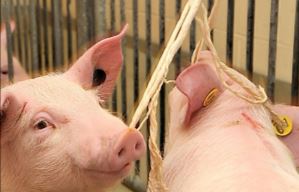



Evaluation of oral fluid as an aggregate sample for early detection of ASF
Early detection is essential to ensure a rapid response and containment of African swine fever.
Early detection would be essential to ensure a rapid response and containment of the disease. This week, the Bob Morrison’s Swine Health Monitoring Project (MSHMP) team shares the summary of a recently published Canadian study looking at using oral fluids as a tool to quickly and easily diagnose ASF.
Key Points
- Oral fluid samples may be used as a low-labor, cost-effective alternative sample source for rapid detection of ASFV during ASF surveillance
- ASFv genome was detected in oral fluids at low-to-moderate levels as early as 3-5 days post-infection, before clinical symptoms started
- Further research is needed to understand limitations and best practices of oral fluid sampling for ASFv
African swine fever (ASF) is a severe and continuing threat to the global swine industry, as evidenced by its rapid spread through Europe and Asia. North American countries are looking to find fast and efficient ways to sample and test for ASF.
Oral fluid (OF) samples have been an effective tool for diagnostics and surveillance of endemic diseases as they don’t require specialized equipment or training. OF samples may offer a faster form of ASF detection as it is widely used in the industry. In previous studies using small groups of ASF-infected pigs, ASF was detected in OF. This study was performed to simulate industry conditions with 20-25 pigs/pen.
Methods
Four experiments with either 20 or 24-25 pigs were performed, two at the National Centre for Foreign Animal Disease (NCFAD) in Winnipeg, CA and two at the Foreign Animal Disease Diagnosis Laboratory (FADDL) at the Plum Island Animal Disease Center (PIADC) in NY, USA. Experiments at NCFAD and FADDL used highly virulent (ASFV Georgia 2007/1) and moderately virulent (ASFV Malta’78) strains respectively. One pig from each group was selected and removed from the pen to intramuscularly infect it with a specific strain. Upon completion of injection the pig was then returned to its original pen. Rope samples were collected regularly in each study, with the exact frequency varying by study. Individual blood, and rectal temperatures and oropharyngeal samples were collected every day or every other day, and pigs were split into two groups to ensure each group was sampled daily. Finally, DNA extraction and quantitative real-time PCR (qPCR) was performed on oral fluids, whole blood and oropharyngeal swabs.
Results
All four experiments had variations in clinical presentation and timeline but showed the slow but steady progression expected of ASFv. All groups reached a 50% mortality at two weeks post-infection and clinical signs observed in the early stages were non-specific such as fever, lethargy, and reduced appetite. In general, the virus was detected in whole blood samples 1-3 days post-infection (dpi) of seeder pigs, and 6-10 days post-contact (dpc) in contact pigs. The virus was detected for the first time in oral fluid samples at dpi/dpc 3-5; however, oral swabs from all seeders were positive at dpi 3. Contact pigs yielded positive oral swabs at 3-5 dpc.
Discussion
The purpose of this study was to evaluate the feasibility of using rope-based oral fluid sampling as an early detection method for ASFv monitoring and detection. Research has shown that it may take 13-19 days before mortality rates indicate an infection, even with a virulent ASFv strain. Additionally, current practice often treats clinical symptoms of fever, lethargy, and reduced appetite with antipyretics and antibiotics. Therefore, unless infected pigs are sampled individually, ASFv infections may not be identified until a high mortality threshold has been reached or pigs start showing disease specific symptoms. Whole blood is currently the approved sample type for detecting ASFv infected animals. The labor, resource, and time intensive nature of whole blood-based surveillance is costly to the industry and may make disease detection difficult. Oral fluids may provide a low-cost and low-labor alternative to surveillance. The aggregate nature of oral fluids may reduce the risk of missing infected pigs compared to random individual sampling.
The results of these four experiments show that aggregate oral fluid samples detected ASFv infection at a dpi range a day or two after whole blood detection in seeder pigs, and comparable to oropharyngeal swabs samples for both seeder and contact pigs. Further research is needed to understand the limitations and best uses of oral fluids as a monitoring method for ASFv. Based upon this study and previous research, oral fluid sampling can be used in conjunction with other surveillance strategies like testing dead and sick pigs, and random individual sampling, as a convenient and cost-effective way to monitor for ASFv in herds.
Full paper can be found at: https://doi.org/10.1111/tbed.14175
The previous editions of the MSHMP science page are available on the MSHMP website.






